
Black Bear & Mountain Lion aka Cougar
Redwood National and State Parks
Copyright 2009 by Mario Vaden
Two of the largest animals in Redwood National and State Parks besides the Roosevelt Elk are Black Bear and Mountain Lion, also called Cougar.
I've seen several of each species there personally. Its interesting that the most abundant traces of Black Bears that I saw in a several year period just happened to in the region near Hyperion. It reminded me of Blue Ledge Mine near Applegate Lake, where in 4 visits I saw black bears twice and traces once. One time coming back down from the mountain, fresh prints were in snow overlapping mine: the bear had sniffed my tracks, but left. That was east near Red Buttes Wilderness. The same region near Hyperion had Cougar tracks too.

One year, a few of us exploring together saw 3 Mountain Lions running in that Redwood National Park, not far away. These cats can leap 16' vertical and 30' horizontal. I also saw Mountain Lion tracks to the north in the Valley of the Lost Groves.
Black bear attacks are uncommon but trend predatory when they occur. So far no face to face for us in Redwood National Park, but I heard that Michael Taylor encountered a bear before, and others have seen them yearly.
Mountain Lions - Cougars
Mountain Lion notes in case you find tracks or see a Cougar in Redwood National Park:
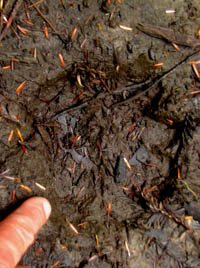
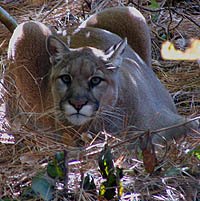
The Parks office may appreciate a report about sightings of the Mountain Lions. I filled out a sighting card for the 3 Cougars mentioned above.
Likewise if you see Black Bear. In June 2010, I saw 5 different Black Bears in 5 different areas of Redwood National Park within 2 days.
The small sighting cards from the visitor centers, only take a few minutes to fill out. There are just a few lines to fill out. It's not like a big application.
Photos: The photo to the left shows an adult Mountain Lion. That pic was taken in southern Oregon, east of Jedediah Smith Redwoods State Park. The photo to the left is one a Mountain Lion track I found in Redwood National and State Parks on a small flat near a creek.
Mountain Lions live throughout the northern California and southern Oregon area.
- Look for overall round shape of the track, common to most felines. The mountain lion's front foot has 4 toes and heel that registers, which means they make an imprint.
- The front foot is larger and more asymmetrical than the rear.
- The palm of the track is almost twice the size of the digits, unlike canine tracks.
- The heel has a dimple in the middle at the top of the pad just under the two middle toes.
- Between toes and palm pad, is a curved ridge, which some trackers call a linked ridge. Canines have a diamond or pyramid shape in this area.
- Toe shape is oval, and the most striking characteristic is that toes are offset. They point in a different direction from the heel pad with one toe ahead or forward of others.
- One of the outer 2 toes is forward of the other. Dog toes point straight or slightly toward each other.
- If you try to draw an X between a mountain lion's toe pads, note that the X crosses into the heel pad.
- If you draw an imaginary X between dog toe pads, the X does not go into the foot pad. Sometimes you can see claw marks left by a dog above toe pads of the print, not always obvious.
The X trick is not really needed. It's doubtful you will be casting fresh tracks: but just hiking.
Black Bears in the Redwoods
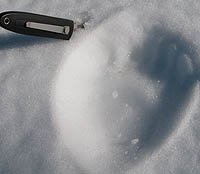
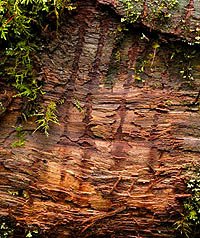
Photos: the top left photo is a Black Bear foot print I saw in the winter, east of the redwoods in northern California. The photo to the right is a claw mark on a log near a creek. The bottom is Black Bear we saw, tearing apart an old trunk looking for food.
Will you see a bear? Not likely. But as mentioned above, I have seen 5 different bears in 2 days, all in different parts of Redwood National Park So if you happen to see one or more during your visit, that would not be unusual.
Trivia about Winnie-the-Pooh: Winnepeg was a female black bear at London Zoo, 1915 - 1934. Bought as a cub for $20 in Ontario, by Lt Harry Colebourn of a Canadian cavalry regiment during World War I, Winnie was smuggled into Britain as a mascot. Before leaving for France, Colebourn left Winnie at London Zoo. One fan was A. A. Milne's son Christopher Robin, who named his teddy bear “Winnie” giving Winnie-the-Pooh his name.
These animals are strong even though they may lack an outline of chiseled muscles. Black Bears look sort of rounded and fuzzy. But their lives are spent climbing steep hillsides and the redwoods on a daily basis. Weight is in the 200 to 360 lb. range.
Considering that hikers and campers pack food on trails and near campsites, note the food storage tips. Here are a few excerpts I found from the park service regarding Black Bear:
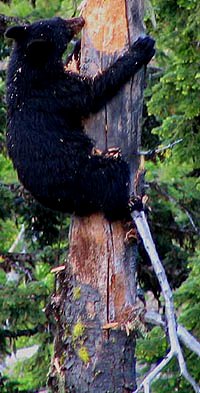
- The highest density of black bears (Ursus americanus) in California roam the forests and oak woodlands of Redwood National and State Park.
- Check in at park visitor centers for information on campgrounds with bear-proof lockers. If your campground does not have lockers, you may be able to borrow a bear-proof canister to pack in and protect your food.
- If bear-proof storage is unavailable, hang food, garbage, and attractants 10 feet out from a tree trunk and 12 feet up from the ground. Pack all your garbage out with you. Cook and store food at least 100 feet away from where you sleep. Wash dishes immediately after use.
- If a bear approaches: STAND UP and wave your arms. SHOUT and make loud noises. Throwing small rocks in the bear’s direction will usually send it running. Be bold, but use good judgement. If you feel threatened, WALK away, don't run. Do not turn your back on the bear. Do not drop your pack.
- If you see a bear, please fill out a wildlife observation card at an visitor center. If you see a bear in a high-use area (campgrounds, parking lots, etc.) or if a bear has obtained human food/garbage, contact a ranger immediately.
- Between toes and palm pad, is a curved ridge, which some trackers call a linked ridge. Canines have a diamond or pyramid shape in this area.
- Black bears are omnivores. In spring, they eat mainly vegetation. Sometimes they rip bark off trees and eat sweet cambium underneath. Bears use powerful, clawed feet to tear apart logs for ants, termites, and insect larvae. Bears visit oak woodlands for acorns. Nuts and berries are nutritious. Bears are very strong and can tear open car doors, windows and coolers for food. Bears also eat dead animals and occasionally prey on mammals, including young deer and elk. Historically, steelhead and salmon filled streams in this area, food source for black bears.
To open a pdf with much more of this information, see Black Bear Information
For more information see this article if it remains online: Wikipedia Black Bear
That document is supplied by the park service. Providing drawings of tracks, the bear and a diagram showing how to hang or suspend food.